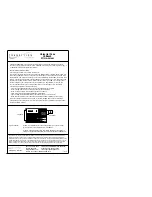
Page 7-7
Installing and Wiring Your System
Installing the Satellite Antenna
7
The most common method to install the pole in the ground is to use cement to secure it in
the hole. Make sure that the pole remains at 90˚ from horizontal as the cement dries. You
may want to use guy wires or braces to keep the pole steady.
A way of ensuring that the pole does not rotate in the dried cement is to cut the bottom of
the pole at an angle, and to place a brick or flat rock in the bottom of the hole to support the
pole before pouring in the cement.
Use a plumb line to ensure that the pole is at 90˚ from horizontal. Take at least three
measurements on different sides of the pole periodically while the cement is drying. Having
the pole plumb allows you to accurately aim the antenna. If the pole is slightly off plumb,
you can still aim the antenna for good reception, but it is very difficult.
Typically, the cable is routed down outside the pole. However, if you want to route the
LNBF cable up through the pole in the same manner as you would through the mast, you
will need to drill a hole in the pole big enough to do this. The hole should be above ground
after the pole has been set in the cement.
You will not need the metal foot and mast assembly provided with the antenna for this
installation, but you should keep the assembly in case you wish to relocate the antenna later.
Follow the instructions for mounting the satellite
antenna on a mast, but use the metal pole in place of
the mast and foot.
Bring the LNBF cable down the outside of the pole.
Make sure to secure the cable firmly, but not too
tightly, to the pole using tie-downs.
















































